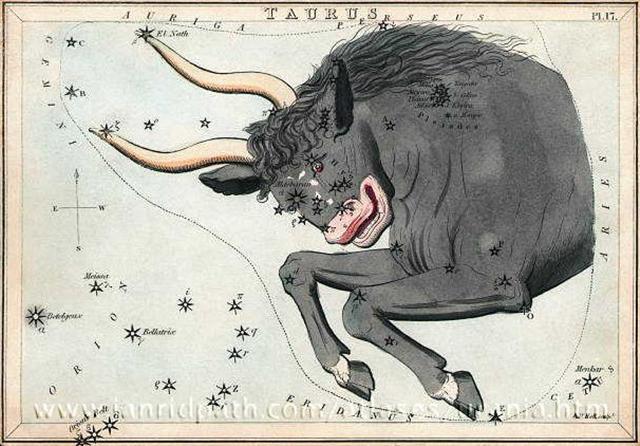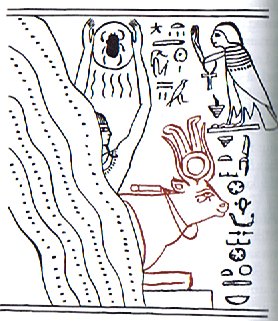3. The Hyades is a star cluster in our Taurus constellation: "From the perspective of observers on Earth, the Hyades Cluster appears in the constellation Taurus, where its brightest stars form a 'V' shape along with the still brighter red giant Aldebaran ... The four brightest member stars of the Hyades are all red giants that began life as A-type stars and have now evolved off the main sequence. All are located within a few light years of each other. Their Bayer designations are Gamma, Delta, Epsilon, and Theta Tauri. They form an asterism that was traditionally identified as the head of Taurus the Bull. Epsilon Tauri, also known as Ain (the 'Bull's Eye'), harbors at least one gas giant planet." (Wikipedia)
The Hyades stars are spread out over a larger timespace than the Pleiades. These are the first 5 of them in order of their visibility and according to Wikipedia:
Ain is listed in my astronomy book and I can use its values to transform the values for the rest:
The declination of Ain is ca 7' less in my book than according to Wikipedia and the right ascension ca 6m less. From there we can make a table of the kind earlier used:
Remarkably day number 472 (= 408 + 64) in the G text corresponds to the beginning of the Hyades cluster:
From earlier we know that vaha mea (the 'red opening') in Ga1-4 probably represents Aldebaran, the great star which once indicated the returning light of summer (north of the equator):
Maybe the peculiar first glyph on side a illustrates the Sacred Jawbone of Muri Ranga Henua, the enchanted weapon which slaughters the evil dark powers of winter. At left there is an element which looks like a kind of henua and at right there is an opening (vaha) not much different from the 'mouth' of vaha mea. The left eye of the Bull is Ain (which means 'eye'). But it is the right eye, Aldebaran, which is the strong one ('male'):
Only the front half of the Bull is seen, and I remember a picture from Wilkinson with Hathor in form of a cow (everything was 'upside down' in ancient Egypt) emerging in a similar manner from the side of a mountain which, he means, represents the burial place on the west bank of the Nile (the Valley of the Kings):
But I can read in the picture that this 'mountain' primarily represents the winter with water flows and droplets. In A Common Sign Vocabulary we saw that Hathor was involved in the return of the Sun King: ... Instead of that old, dark, terrible drama of the king's death, which had formerly been played to the hilt, the audience now watched a solemn symbolic mime, the Sed festival, in which the king renewed his pharaonic warrant without submitting to the personal inconvenience of a literal death. The rite was celebrated, some authorities believe, according to a cycle of thirty years, regardless of the dating of the reigns; others have it, however, that the only scheduling factor was the king's own desire and command. Either way, the real hero of the great occasion was no longer the timeless Pharaoh (capital P), who puts on pharaohs, like clothes, and puts them off, but the living garment of flesh and bone, this particular pharaoh So-and-so, who, instead of giving himself to the part, now had found a way to keep the part to himself. And this he did simply by stepping the mythological image down one degree. Instead of Pharaoh changing pharaohs, it was the pharaoh who changed costumes. The season of year for this royal ballet was the same as that proper to a coronation; the first five days of the first month of the 'Season of Coming Forth', when the hillocks and fields, following the inundation of the Nile, were again emerging from the waters. For the seasonal cycle, throughout the ancient world, was the foremost sign of rebirth following death, and in Egypt the chronometer of this cycle was the annual flooding of the Nile. Numerous festival edifices were constructed, incensed, and consecrated; a throne hall wherein the king should sit while approached in obeisance by the gods and their priesthoods (who in a crueler time would have been the registrars of his death); a large court for the presentation of mimes, processions, and other such visual events; and finally a palace-chapel into which the god-king would retire for his changes of costume. Five days of illumination, called the 'Lighting of the Flame' (which in the earlier reading of this miracle play would have followed the quenching of the fires on the dark night of the moon when the king was ritually slain), preceded the five days of the festival itself; and then the solemn occasion (ad majorem dei gloriam) commenced. The opening rites were under the patronage of Hathor. The king, wearing the belt with her four faces and the tail of her mighty bull, moved in numerous processions, preceded by his four standards, from one temple to the next, presenting favors (not offerings) to the gods. Whereafter the priesthoods arrived in homage before his throne, bearing the symbols of their gods. More processions followed, during which, the king moved about - as Professor Frankfort states in his account - 'like the shuttle in a great loom' to re-create the fabric of his domain, into which the cosmic powers represented by the gods, no less than the people of the land, were to be woven ...
... The king, wearing now a short, stiff archaic mantle, walks in a grave and stately manner to the sanctuary of the wolf-god Upwaut, the 'Opener of the Way', where he anoints the sacred standard and, preceded by this, marches to the palace chapel, into which he disappears. A period of time elapses during which the pharaoh is no longer manifest. When he reappears he is clothed as in the Narmer palette, wearing the kilt with Hathor belt and bull's tail attatched. In his right hand he holds the flail scepter and in his left, instead of the usual crook of the Good Shepherd, an object resembling a small scroll, called the Will, the House Document, or Secret of the Two Partners, which he exhibits in triumph, proclaiming to all in attendance that it was given him by his dead father Osiris, in the presence of the earth-god Geb. 'I have run', he cries, 'holding the Secret of the Two Partners, the Will that my father has given me before Geb. I have passed through the land and touched the four sides of it. I traverse it as I desire.' |
|||||||||||||||||||||||||||||||||||||||||||||||||||||||||||||||||||||||||||||||||||||||||||||||||||||||||||||||||||||||||||||||||||||||||||||||||||||||||||||||||||||||||||||||||||||||











